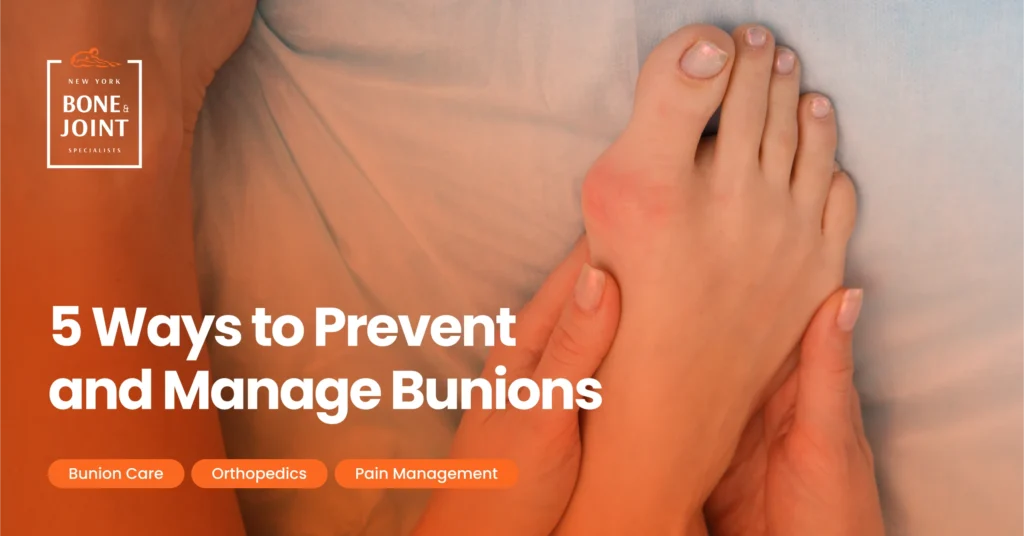Bunions are a common foot ailment, but that doesn’t mean you have to live with the pain.
If you’ve noticed a protruding bump at the base of your big toe, you likely have a bunion — a common foot ailment affecting 23% of U.S. adults. Besides being a cosmetic issue, bunions can make every step agonizing. Yet they can be managed and prevented with some easy tips.
There is no one cause for bunions. Heredity plays a role in that you may have inherited a foot shape that predisposes you to the condition. Also, those with rheumatoid arthritis or who work long hours on their feet have a heightened risk of developing bunions. While ill-fitting footwear may not directly cause bunions, they can make bunions more painful. If you fall into any of those categories, you can take measures to protect yourself from bunions or prevent them from getting worse.
What are bunions?
Your big toe connects to your foot at the metatarsophalangeal joint. When the joint goes out of alignment, often due to extreme pressure, a prominent bony protrusion forms, and the toe bends toward the second toe. In addition to pain when putting pressure on the big toe, bunions can also cause swelling, calluses and corns, and numbness.
Without treatment, bunions may lead to more serious foot issues, such as bursitis, an inflammation of the fluid-filled sacs that cushion the toe joint. Bunions can also cause the middle joint of the second toe to bend out of alignment, resulting in a painful hammertoe.
Five ways to prevent and manage bunions

Bunions can be prevented. But even if you already have a bunion or notice the beginning of one, you can manage the discomfort and avoid making the condition worse by following these five tips:
Get comfy shoes. Yes, this means giving up those pointy-toed high heels, at least for a while. Instead, buy shoes with a wide toe base to comfortably accommodate your toes. Look for footwear with strong arch support because flat feet can also cause bunions. Then, measure the slope from the heel to the toe pad. For a comfortable fit, it should be less than 12 millimeters.
Exercise your feet. Bet you don’t think too much about exercising your feet, but you should. Simple exercises can keep your feet strong and flexible. Try these two: Sit in a chair and place marbles in front of you. Try picking up the marbles with your toes. Or, sit with your feet on the floor. Then, lift and spread your toes apart as far as possible.
Buy orthotics. A variety of devices are available for bunion care, either commercially or through a prescription. For example, you can buy bunion pads to cushion the bunion in your shoe. Another option is a custom orthotic to separate and maintain the proper alignment of your toes in your shoes. There’s also a nighttime toe splint that can keep your toes aligned while you sleep. If you want to explore the world of orthotics, talk to a podiatrist to find the right one for you.
Monitor your feet. Put your foot on a piece of paper and outline its shape. Have there been any changes? Do you notice a bump on the side of the big toe, however slight? The earlier a bunion is treated, the more likely you can prevent it from becoming worse and more painful. Also, know your family history. If one or more family members have had bunions, you should regularly monitor your foot for any changes that could indicate a bunion.
Give your feet a rest. Your feet take a pounding each day, so it’s vital to give them a rest, especially if you work on your feet all day long. At home, walk barefoot or in comfortable shoes, and soak them in a warm bath If they’re painful or sore.
These conservative methods should help relieve the pain. And if you are at risk of bunions, you can prevent the condition with these tips. However, if these measures fail to work, you may need bunion surgery to remove the bone spur and reposition the toes. Recovery can take up to four months.
Get back into step
New York Bone & Joint Specialists is a leading sports medicine center. As such, we have helped hundreds of patients overcome foot pain caused by bunions or other foot ailments. Let us diagnose your condition and prescribe a treatment plan to get the spring back in your step. Contact us today for a consultation.




